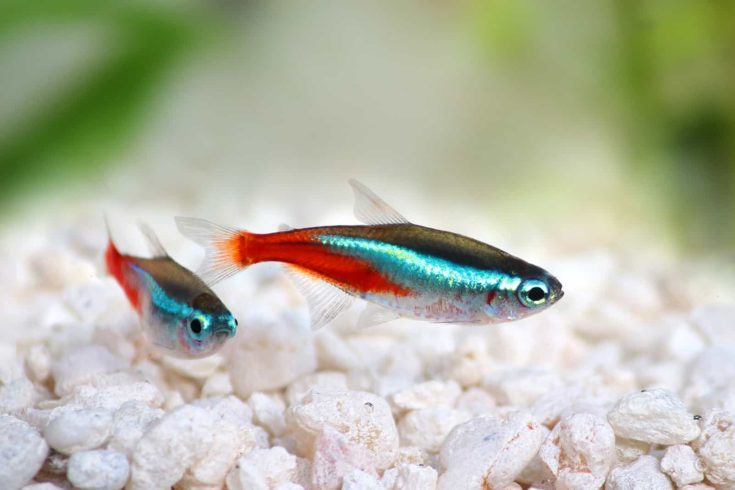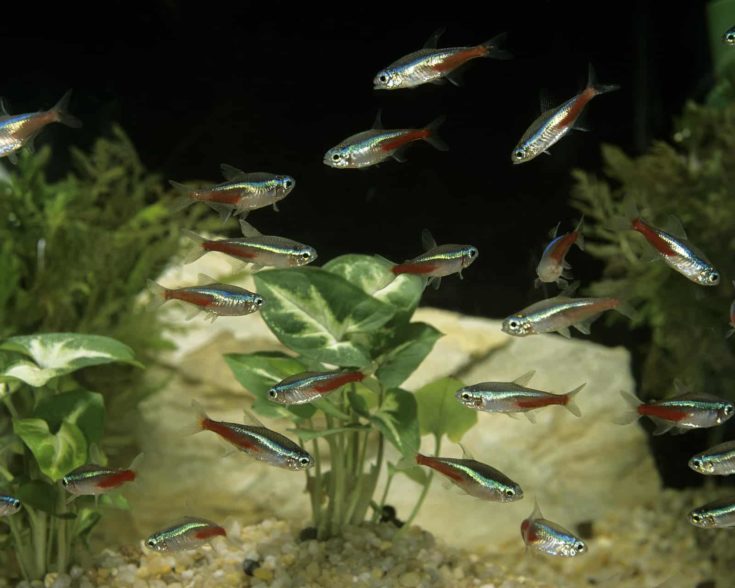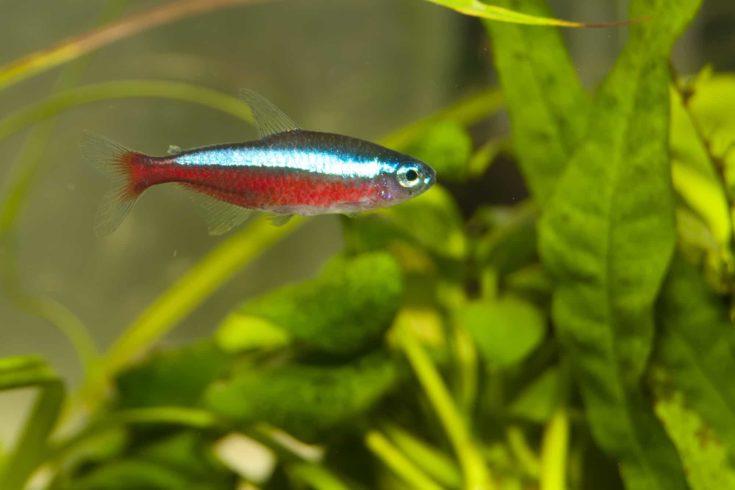Neon tetras are known for their hardy disposition – it’s the reason why they are one of the most commonly recommended fish for beginners. However, these distinctive-looking fish are prone to a particular type of parasitic infection known as the neon tetra disease.
The neon tetra disease was named after its prevalence within the species. It is caused by a parasite known as Pleistophora hyphessobryconis. Common as this disease may be, it is by no means the only reason neon tetras get sick. Let’s take a look at a few other reasons:
Why Do Neon Tetras Get Sick?
Stress
Because of their diminutive size, neon tetras are prone to stress caused by more aggressive tankmates. They may encounter territorial disputes, relentless chasing, or even biting. Unfortunately, these small, peaceful fish typically have no means of fending for themselves.
Here are two key signs of a stressed-out neon tetra:
1. Weight Loss
Neon tetras placed in stressful conditions tend to lose weight from malnutrition. Fish that are stressed out lose their appetites or are simply too afraid to feed. In some cases, neon tetras are simply unable to compete with their tankmates for food.
2. Darting
Fish that are stressed out may dart from end to end of a tank, or “glass surf” by swimming right by the sides of an aquarium. They typically do so to secure a means of escape from the stressful conditions of their habitat.
3. Hiding
If your fish are stressed out, odds are you’ll rarely see them. Why? Fish that are stressed out will hide to protect themselves or to escape detection by their aggressors. This is a completely natural response, and definitely one you should keep a lookout for.
Poor Water Parameters
It comes as no surprise that poor water conditions increase your fish’s risk of falling sick. The quality of your neon tetra’s habitat has a significant impact on its immunity, stress levels, and health outcomes.
When it comes to maintaining ideal water parameters, testing is key. Make sure that ammonia and nitrite levels are at safe, non-toxic levels. Provide your fish with water at a pH, hardness, and salinity that best matches their natural habitat. Above all, do check that your filter is working as it should!
Commercial Breeding
The gorgeous and distinctive appearance of neon tetras has made them prime candidates for commercial breeding in recent years. While wild-caught neon tetras retain the resilience and hardiness the breed is known for, commercially bred variants generally do not.

Commercially bred neon tetras tend to be less resilient than their wild counterparts due to generations of interbreeding. They are also raised in environments that are not conducive to developing strong immune systems.
If your neon tetras are falling very often, it might be worth looking for fish from more reliable sources. Source your fish from breeders that practice good husbandry, as they are likely to produce hardier fish. We guarantee it’s worth the effort!
What Is Neon Tetra Disease?
Having taken a look at some of the key factors that cause neon tetras to fall ill, let’s take a closer look at neon tetra disease and what it means for your fish.
While rare, neon tetra disease is a parasitic infection caused by a microsporidian parasite. In spite of its name, this disease can also be found in other families of fish, such as barbs, rasboras, and danios.
As is always the case with infectious diseases, prevention is the best way to prevent your fish from dying Here are a few key symptoms to look out for:
Symptoms of Neon Tetra Disease in Fish
The degenerative nature of neon tetra disease means that milder, subtler symptoms will present themselves first, before more severe signs become evident. Here’s a list of symptoms to expect as the disease progresses:
Early Indicators of Neon Tetra Disease
The earlier signs of neon tetra disease are often subtle and harder to spot. These symptoms are characteristic of many other types of bacterial and parasitic infections, which is why this disease is frequently misdiagnosed.
However, it is important to keep these early symptoms in mind. Spotting the disease early allows you to separate sick fish from the rest of its tankmates. This helps protect the rest of your tank against the disease.
Restlessness
One of the first symptoms of neon tetra disease is restlessness. Your fish will begin to deviate from its usual swimming patterns. Fish that typically enjoy swimming in schools may straggle from their shoals. They may also swim in erratic patterns and directions.
Hiding
Fish that fall ill tend to retreat to safe hiding spots or crevices to recover. In that regard, they are just like us humans! Neon tetra disease can sap the energy out of your fish, causing them to hide. This is why hiding is one of the first signs to look out for.
Losing Coloration
By the time your fish begins to lose coloration, the disease has already started attacking your fish’s muscle tissue. The density of pigment cells in affected tissue can be drastically reduced by Neon Tetra Disease, making this one of the key signs that your fish is ill.
While fish can turn pale for reasons unrelated to neon tetra disease, the key distinguishing factor to look out for is localized fading. While your fish’s entire body may turn pale from time to time in response to stress, Neon Tetra Disease causes fading in a specific part of your fish’s body.
Late Indicators of Neon Tetra Disease
The late indicators of neon tetra disease cause considerable suffering on your fish’s part. By the time these signs become evident, the disease has already caused significant damage to your fish’s health and well-being.
These symptoms may also progress at a more rapid pace compared to some of the earlier signs. They are also easier to spot because they cause more severe deformities.
White Cysts and Bumps
The progression of neon diseases causes white cysts and bumps to form on your fish’s body. After entering your fish’s body, the parasite burrows its way through the intestinal wall into your fish’s muscle tissues, causing cysts to form. This will cause your fish to lose a considerable amount of strength.
Curved Spine
As parasites continue to attack your fish’s body, bits and pieces of its muscular system begin to waste away. This causes the spine of your fish to take on a bent appearance. This is one of the final signs of neon tetra disease.
Difficulty Moving
The culmination of all these symptoms ultimately results in sick fish that are rendered immobile by the disease. These fish will find it near-impossible to swim, search for food, and fend for themselves. In this weakened state, your fish will find it increasingly difficult to protect itself against the disease.
False Neon Tetra Disease
Okay, so we’ve discussed the signs and symptoms of neon tetra disease at length. But just because your fish has some of the classic symptoms of neon tetra disease, doesn’t mean that all hope is lost.
False neon tetra disease, otherwise known as columnaris, is a bacterial infection with symptoms that closely resemble that of neon tetra disease. In its early stages, fish become withdrawn and stop eating. As the disease progresses, infected fish may lose coloration, before finally suffering from a curved spine and immobility.
The similarities between the two diseases are striking, but false neon tetra disease is significantly easier to cure. Hobbyists can typically rely on broad-spectrum antibiotics to cure the disease, particularly in its early stages.
Though false neon tetra disease is less infectious, it remains important to quarantine fish that appear ill.
How Long Does Neon Tetra Disease Take To Kill?
Neon Tetra Disease can take anywhere between two weeks and two months to kill your fish. Fish with weakened immune systems are likely to succumb to the infection more quickly than fish that are previously healthy.
Unfortunately, the prognosis is unfavorable under both situations. Neon Tetra Disease might be rare, but it is notoriously difficult to treat. The best outcome is one where the rest of the tank is spared from the disease.
Causes of Neon Tetra Disease
Neon tetra disease is caused by the Pleistophora hyphessobryconis parasite. In most cases, parasites enter the body of the host fish via live foods. Fish can also be infected when they feed on the bodies of fish that were killed by the disease.
Though the disease is transmitted via intermediary hosts, it thrives under specific conditions. Here are some of them:
- Warm water (77°F and above)
- Organically rich
- Low pH
- Low dissolved oxygen
These conditions increase the likelihood of a Neon Tetra Disease outbreak. Therefore, it is imperative to keep your water clean.
List Of Fish That Can Catch Neon Tetra Disease
Neon Tetra Disease was first spotted in neon tetras, but other fish are also vulnerable to the disease. Small, freshwater fish are the most common victims. Here’s a list of fish that can catch neon tetra disease.
- Angelfish
- Rasbora
- Guppies
- Killifish
- Barbs
- Danios
- Other Tetras
Given the prevalence of the disease among ornamental freshwater fish, you should always take extra care to protect your fish.
Treatment
Neon Tetra Disease is highly contagious and near-impossible to cure. The first thing to do is to remove all sick fish from the tank to protect the rest of your stock. After that, here are a few things you can do:
Antibacterial Treatment
One of the first things you should do is provide your fish with anti-bacterial treatment. Broad-spectrum antibiotics bought from fishkeeping stores are a good way to go, or you can opt for prescription antibiotics from a trusted vet.
It is important to provide your fish with antibacterial treatment for two reasons:
1. Preventing Misdiagnosis
The symptoms of Neon Tetra Disease are fairly general, making an accurate diagnosis difficult for hobbyists. In some cases, what resembles Neon Tetra Disease might actually be a form of bacterial infection that is easily cured. If this is the case, treating your fish with antibiotics may save it.
2. Treating Secondary Infections
Occasionally, secondary infections such as fin rot may occur as part of Neon Tetra Disease. Antibacterial treatment may alleviate some of these secondary infections, providing your sick fish with a greater degree of comfort.
Medicated Bath
Medicated baths are exceptionally useful for treating parasitic infections that take place externally. One common example is ich, which causes white spots to appear on the surface of your fish’s skin.
Unfortunately, medicated baths are less successful at treating Neon Tetra Disease because it is a parasitic disease that takes place internally. However, giving your fish a medicated bath allows you to maximize its odds of survival.
Cleaning The Tank After An Infection
Once a fish has been infected with Neon Tetra Disease, your tank should be disinfected to thoroughly rid your aquarium of the parasites. Here’s a quick guide on how to do so:
- Make a bleach solution consisting of one part bleach to eight parts of water.
- Spray your tank, decorations, filters, and heaters with the bleach solution.
- Leave it to sit for 15 minutes.
- Rinse the tank and allow it to air dry for 24 hours.
- Fill your tank with dechlorinated water, and empty it after 2 hours.
- Refill your tank with dechlorinated water, cycle your aquarium, and you’re good to go!
In some cases, it may be prudent to cull your livestock if there has been a significant infection in your tank. Though some fish may not exhibit symptoms, they may act as carriers of the disease.
How to Prevent Neon Tetra Disease
Because Neon Tetra Disease is impossible to treat, prevention is without a doubt the best form of cure. Here are our top tips on how to prevent neon tetra disease from infecting your tank.
Purchase Fish from Reliable Breeders
In many cases, Neon Tetra Disease is introduced to a tank by new fish that have been infected by the disease.

The best way to manage this risk is to purchase fish from trustworthy sources. Get to know your local fish suppliers, and avoid purchasing fish online. These steps make it more likely for you to find healthy, disease-free fish for your aquarium.
Use High-Quality Food Sources
Live foods can sometimes act as intermediaries for parasites that cause Neon Tetra Disease. Some examples include tubifex worms and brine shrimp, which have been known to serve as hosts for microsporidian parasites.
Therefore, it is important to purchase from food producers that practice good husbandry.
Keep the Environment Healthy

Keeping your fish’s environment healthy achieves two things. First of all, it keeps your fish’s immune system strong. Secondly, it makes it harder for microsporidian parasites to thrive. Ultimately, this significantly lowers the odds of Neon Tetra Disease infecting your fish.
To maintain ideal living conditions for your fish, here are a few things you should always do:
Water Changes
Water changes involve replacing some or all of the water in your fish tank with clean water. This allows you to lower the concentration of harmful substances in your aquarium, creating a healthier environment for your fish.
Water Testing
Water testing provides you with a concrete way of determining if the substances in your water are at a safe and manageable level for your fish. There are a myriad of test kits available on the market. Here are some parameters that are commonly tested for:
- Nitrates
- Nitrites
- pH
- KH (Carbonate Hardness)
Filter Maintenance
Maintaining your aquarium filter is crucial in order to maintain its efficiency.
You should clean your filter approximately once every four weeks. This figure varies depending on the type of filter used but serves as a good rule of thumb for hobbyists erring on the side of caution.
UV Sterilization
UV sterilization is one of the best ways to keep single-celled pathogens under control in your tank. Water is passed through an ultraviolet light source, which emits a radioactive wave to kill organisms such as algae, bacteria, and viruses.
With such a wide variety of UV sterilizers available on the market, it is important to choose the right UV sterilizer unit size for your tank.
Frequently Asked Questions
Is it possible to completely eradicate the disease from a tank even after infection?
Yes, it is completely possible to eradicate the disease from a tank after a wave of infections.
After the infected fish have been removed, you need to sterilize the entire tank and its contents with a bleach solution containing one part of bleach to eight parts of water.
In cases of severe infections, you may need to consider culling your fish to prevent future outbreaks.
Do all Neon Tetras carry this disease?
Absolutely not. Neon Tetra Disease got its name because of the fish it was first discovered in, but it can affect a wide variety of freshwater fish.
What are some of the best ways to spot the disease early on?
One of the best ways to spot the disease early on is to keep a lookout for irregular or erratic behavior. The earliest signs of Neon Tetra Disease cause changes in eating habits, swimming patterns, and shoaling behavior. It may also cause your fish to hide.
What Fish Are Immune To Neon Tetra Disease?

Most freshwater fish can catch the disease, but cardinal tetras are known to be immune against it. There is no conclusive reason as to why this is the case, but this is certainly a useful fact to bear in mind!
Conclusion
At the end of the day, Neon Tetra Disease is one out of many illnesses that can affect your fish. While it is certainly one of the harder diseases to cure, it is a fairly rare disease. Take good care of your fish, and they’ll stay strong and healthy!
Did you enjoy this article? If you did, don’t forget to share it with someone else who might find it helpful!
